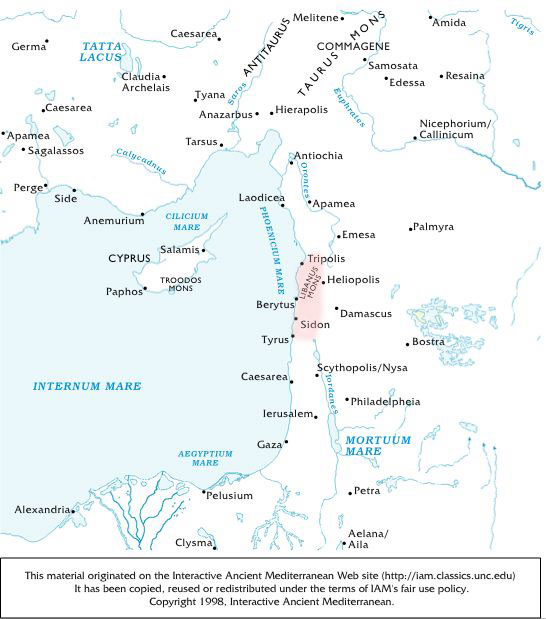Phoenicia; an Asiatic country on the Syrian coast. It was bounded on the north by the river Eleutherus, on the south by Mount Carmel, and on the east by Palestine and Coelesyria. It largely consisted of fertile, well-watered valleys, its chief rivers being the Eleutherus, the Sabbaticus, the Tripolis, the Adonis, the Lycus , the Magoras, the Tamyras, the Leo, the Lita, the Belus, and the Kishon. Its principal cities were Sidon, Tripolis, Byblus, Tyrus, Berytus, and Ptolemaïs. Phoenicia being little more than a narrow strip of coast, was almost necessarily a maritime country, and its cities for many centuries were at the head of naval power in ancient times. See Sidon; Tyrus.Their commerce extended over the known world, and they became everywhere known for their traffic and dyestuffs, especially the Tyrian purple, glass, tin, and amber. They also, in connection with their commerce, established many colonies within the Mediterranean on various islands (see Cyprus), on the north coast of Africa (see Carthago), and even on the western coasts of Spain and Africa. They also had settlements on the Euxine Sea. In Gaul the city of Massilia was founded by the Phoenicians.
In race the Phoenicians must be classed as Semitic, as is evident from the language which they spoke and of which our knowledge is derived [p. 1246] from a large number of inscriptions, mostly mortuary and votive, found in Phoenicia itself and more numerously on the site of Carthage and Citium. A number of Phoenician phrases are found transliterated in the comedy of Plautus mentioned below. The native Phoenician literature seems not to have been extensive, and of it nothing has been preserved except some fragments such as the Greek translation of Sanchuniathon and Hanno. The inscriptions, such as they are, cover, roughly speaking, a period extending from B.C. 600 to A.D. 250. Like the other Semitic languages the Phoenician is written without the vowel points. Some scholars have regarded the language as being so closely allied to Hebrew as to be almost capable of classification as a Hebrew dialect. Phoenician is more archaic in its structure, simpler in its syntax, and with an apparently limited vocabulary, but this last is perhaps an unsafe generalization owing to the fact that so little material has survived from which to judge of it. The Phoenician script is the prototype of the Greek and Roman alphabets as well as of the principal Semitic scripts. The oldest specimen of it is the Moabite Stone (q v.). The origin of the Phoenician itself is doubtful. Some scholars, like De Rouge, consider it a derivative from the Egyptian hieroglyphics. The language spoken in Carthage was practically the same as the original Phoenician, with differences in the pronunciation and orthography, and to some extent in the script. A curious bit of Phoenician exists in the Poenulus of Plautus, where one of the speakers utters some sentences in Carthaginian. The interpretation of the passage has puzzled scholars for generations. See Poenulus.
The influence of the Phoenicians upon Greek art has some importance, as from them the Greeks borrowed the types for all their early gold and silver work and for their vase patterns. The Greek religion was also influenced by them, on which see the article Aphrodité.
The internal history of Phoenicia is not very well known, nor is its form of government thoroughly understood. Particularism seems to have been its character, and the different cities of Phoenicia were practically independent of one another. Hence, at different periods, they fell an easy prey to invaders from Egypt, Assyria, Macedon, and Rome. At the earliest period of which we have any knowledge Phoenicia is found a dependency of Egypt, ruled by Egyptian governors and paying an annual tribute. About B.C. 1300 Egypt lost this hold owing to internal disturbances, which compelled her to give up her foreign possessions, and for several centuries after this the importance of the Phoenicians attains its height. About B.C. 800 the Assyrians obtained at least a nominal control and exacted tribute from the Phoenician cities, though without interfering with their commercial importance. Subsequently they were subdued by the Babylonians, the Persians, and the Macedonians, and under the Romans Phoenicia was incorporated into the province of Syria, while under the Empire it became the province of Phoenicé Libanensis.
For the history, see Rawlinson's History of Phoenicia (London, 1889); Mover, Die Phönizier (3 vols. Bonn, 1841-50); Prutz, Aus Phönizien (Leipzig, 1876); Duncker, History of Antiquity, Eng. trans. book iii. (London, 1877); Sayce, Ancient Empires of the East (London, 1884); Pietschmann, Geschichte der Phönizier (Berlin, 1889). On the language, see Levy, Phönizische Studien (Breslau, 1864); Schroeder, Die phönizische Sprache (Halle, 1869); and Bloch, Phönizisches Glossar (Berlin, 1891). The most complete collection of Phoenician inscriptions is that in vol. i. of the Corpus Inscriptionum Semiticarum (Paris, 1881-90). (Harpers Dictionary of Classical Antiquities, 1898)
